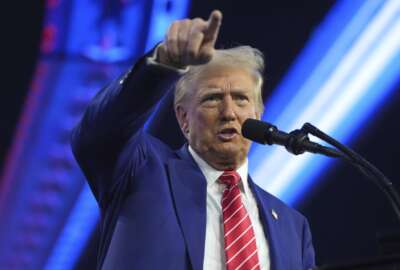Innovation: The Federal Frontier
With increased budget constraints, how can agency leaders engage in new and existing innovations that encourage effective collaboration between the public and...
wfedstaff | April 17, 2015 3:49 pm
As technology continues to grow at an exponential rate, government must make innovation a necessary priority for future growth and improved mission outcomes. With increased budget constraints—how can agency leaders engage in new and existing innovations that encourage effective collaboration between the public and private sector? Join the conversation with César Hidalgo, Assistant Professor, MIT Media Lab and JR Reagan, Principal, Deloitte & Touch LLP as they discuss innovation and its role in the Federal government.
Guests:
César Hidalgo, Assistant Professor, MIT Media Lab and Faculty Associate at Harvard University’s Center for International Development
JR Reagan, Principal, Deloitte & Touch LLP and Deloitte Center for Innovation Leader
Show highlights:
• A macro view of innovation trends around the world and in the US
• How government can accelerate and drive innovation efforts
• How leaders can combat budget pressures and impact innovation within their agency
• Cues from the public sector on how agencies can encourage innovation throughout the workforce
The following is a full transcript of FedCentral’ s interview with Cesar Hidalgo, Assistant Professor, MIT Media Lab and Faculty Associate, Harvard University Center for International Development and JR Reagan, Principal and Federal Chief Innovation Officer at Deloitte & Touche, LLP, conducted by Jane Norris on June 7, 2012. To listen to the full interview go to http://www.deloitte.com/us/fedcentral.
Jane Norris
Welcome to FedCentral brought to you by Deloitte. A program where executives and federal government leaders talk about the issues and initiatives that are making a real impact on the business of government today to help government help America. There’s no denying innovation will be critical to helping the federal government find new ways to increase efficiencies and improve mission outcomes. In these tight times, it’s even more important. Today we’ll be discussing innovation as a top priority for growth and improving government. Joining us to talk about it today, Cesar Hidalgo, an Assistant Professor at the MIT Media Lab and Faculty Associate at Harvard University Center for International Development. Cesar’s work focuses on improving the understanding of systems by using and developing concepts of complexity, evolution, and network science; and JR Reagan is the Federal Chief Innovation Officer and Principal at Deloitte & Touche, LLP. He leads the Deloitte Center for Innovation, a leading-edge demonstration analytics and technology development center very close to Washington, DC. Gentlemen, thank you both for joining us today. Cesar, welcome. I know you’re on the telephone today. Happy to have you.
Cesar Hidalgo
Yeah, thank you, Jane. I’m happy to be here.
Jane Norris
So JR, I’ll start with you. Let me ask you this question: Give us a macro view of innovation trends and how is it impacting governments around the world and especially here in the United States?
JR Reagan
It’s interesting innovation now—people would define it differently. In some cases, we think of innovation as invention which isn’t always the case. It’s more about doing things differently than about doing different things, and what that really means is breaking trade-offs, that we’re used to. We think about those costs. We think about the benefits, and we always think we have to add more cost to get those benefits – not always the case anymore. In one of those things that we’re coming across now is this notion of big data. We have so much data available to us, the data that we own, that we create inside of our agency, and all of that data that unstructured data out there that citizens are creating and companies are creating, social media and things like that. So combining this gives us some really great new ways of doing what we did in the old way and doing it differently. Cesar, I know that you’ve been looking at some of these examples in your work. How are things different now with this notion of big data?
Cesar Hidalgo
That’s a great question, and I think the best way of illustrating it is by using a specific example. Both you and Jane remember the Japanese earthquake that happened a little bit more than a year ago?
JR Reagan
Sure.
Cesar Hidalgo
I remember I was in Japan on January and I met a group of people from Dentsu, this is a large advertising company, and they showed me one project they had done, in collaboration with Honda, after the earthquake. The project was called Connecting Lifelines and actually was a project in which big data was used to assess which roads were operational after the earthquake. The project actually was very simple. You would see a large map of Japan and the clock would be running, and as the clock would be running, you would see these little dots that would start moving around—sort of like drawing traces. Each one of these dots was actually the GPS of one of the Honda cars, and that showed how they were able to use all of the data that was being collected automatically and seamlessly by people that were driving right after the earthquake to determine which roads were operational and which roads were not.
Now I found that to be an excellent example of how big data is changing the way that you can do things because this is a task that in any case would need to be performed by a government and would be performed through a network that would be much more formal, much slower, and it would take probably a large effort just to assess which roads were operational or not, and here the designers were showing in this very simple example how they were using big data to actually create a map that was much needed at the time.
Jane Norris
So that would also involve geospatial intelligence, I would imagine.
Cesar Hidalgo
Absolutely. Actually, it involves a variety of things besides analytics; you can think that also involves the ability to actually collect the data and the rights to collect that data. This is a thing where one of the biggest constraints of big data at the moment, that everyone is sort of afraid about different angles of the privacy question, and data’s been locked up or traded mostly in the black market. If you think about in this collaboration, this was made possible because Dentsu is the advertisement company of Honda and they’re already working together and they have a relationship.
JR Reagan
Yeah, the –
Cesar Hidalgo
Now –
JR Reagan
Go ahead, Cesar.
Cesar Hidalgo
So now my question would be, would the government of Japan or the government of any country been able to come up with a map as quickly as the one that the private sector did using the data that they had available? My intuition is they probably would not have, because there would have been too much permission that would have needed to be requested in order to create the map.
Jane Norris
So in my recent past, I remember that the Geospatial Intelligence Agency did actually have to use mapping techniques in order to figure out where to go during Hurricane Katrina because the roads were all covered over. So governments do allow those things do happen. JR?
JR Reagan
Yeah, it’s a great example where a lot of what used to be the domain of government, now we have that ability outside of government to do some of those same things and even cheaper, and it’s a good wake-up call for government to look around, look in its cupboards, so to speak, and say what do we have now that we can combine with different things, especially for geospatial. Cesar had talked about Japan. We see that a lot in crisis mapping all over where we can actually take a lot of the visualization and apply that to lots of different problems. It could be food and product safety. It could be even things as mundane as where are folks going in terms of vacations and where we might need services for that. All this becomes a new way for us to look at this data and combine it in different ways we didn’t have the ability for before.
Jane Norris
So there are different explanations of what big data is. Can you give us your view of what big data is, and then Cesar, I’ll ask you, too?
JR Reagan
We used to think of it solely as the data that I own, and now big data is what we call digital exhaust. It’s produced in all of the different things that we do from buying gasoline at a pump produces data from a credit card transaction to the cell phones types of things. Everything is emanating this data. When you include that with the data that you own inside your four walls, now we get that definition of big data and that’s how I view it.
Jane Norris
And so Cesar, what does is it mean to you, big data?
Copyright © 2024 Federal News Network. All rights reserved. This website is not intended for users located within the European Economic Area.





